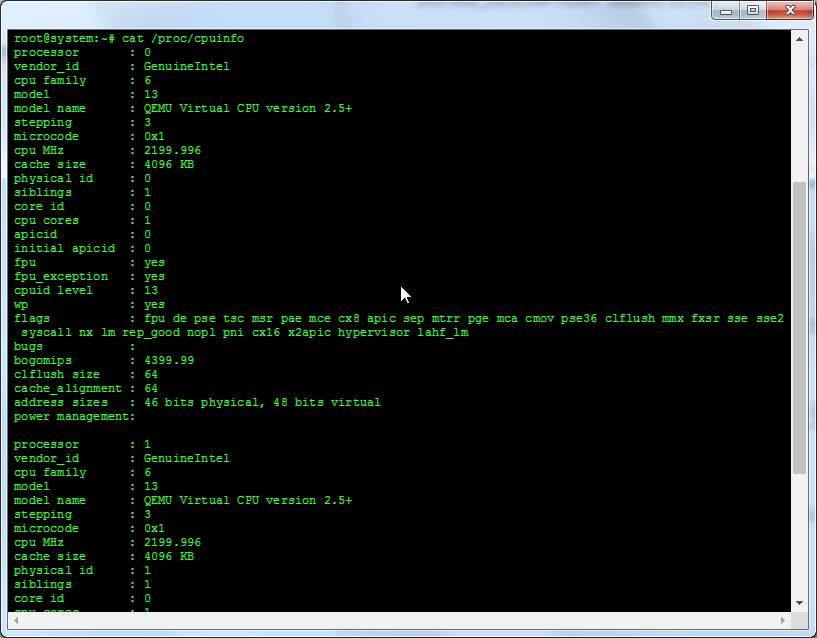

This indicates that VT is indeed enabled on my processor. You can see that the “QEMU: checking for hardware virtualization” shows the result status as PASS on my system. The following virt-host-validate command from this utility will help you in verifying if virtualization is supported by your processor or not, among many other things: $ virt-host-validate
CPUINFO UBUNTU INSTALL
Since most Ubuntu systems do not have this facility by default, you can install is by running the following command as sudo: $ sudo apt install libvirt-clients In order to use this, you need to have the libvert-clients package installed on your system. There is a virtual host validation tool called virt-host-validate. Method 4: Through the Libvirt client utility If you do not find any output for this command, this emans that the /proc/cpuinfo does not contain any information about VT and it is either unavailable or disabled from your BIOS settings. The vmx indication and it’s information in the output indicates that the virtual technology, Intel-VT, is enabled and supported by my system. This is the output of the above-mentioned command on my system: Vmx: Intel-VT technology support information In the output you will see information about one of the following, that will verify that virtualization is enabled on your system: For example, because we want to extract virtualization related information, we can use egrep command as follows to extract information related to either svm or vmx: $ egrep "svm|vmx" /proc/cpuinfo We can also manually extract relevant information from the /proc/cpuinfo file by using the egrep command. KVM acceleration can NOT be used Method 3: From the /proc/cpuinfo file INFO: Your CPU does not support KVM extensions However, if you get the following output, it means that you need to enable virtualization to use applications that work on this technology: The above output indicates that VT is enabled on your system. The following command from this utility will help you in verifying if virtualization is supported by your processor or not: Advertisement $ sudo kvm-ok Please enter y and hit Enter after which cpu-checker will be installed on your system
CPUINFO UBUNTU SOFTWARE
Please note that only an authorized user can add/remove and configure software on Ubuntu.Īfter you have entered the password for sudo, the system might prompt you with a y/n option to verify if you want to continue installation. Since most Ubuntu systems do not have this facility by default, you can install is by running the following command as sudo: $ sudo apt-get install cpu-checker The cpu-checker utility is another way to check virtualization technology, among many other things. Method 2: Through the cpu-checker utility Navigate to the Virtualization output the result VT-x here ensures that virtualization is indeed enabled on your system. Here is the output format you usually see: Simply run the following command in your Ubuntu Terminal: $ lscpu This information includes the number of processors, CPU operation mode, sockets, cores, threads, model name, and virtualization information, among much more. This command extracts hardware information from the /pro/cpuinfo file of sysfs. The lscpu command is a popular method to extract information about your CPU’s architecture. Verifying VT on your processor Method 1: Through the lscpu command You can open the Terminal application either through the system Dash or the Ctrl+Alt+T shortcut. We will be using the Ubuntu command line, the Terminal, in order to verify VT on our processor.

We have run the commands and procedures mentioned in this article on a Ubuntu 18.04 LTS system. The article explains the following methods to check if Virtual Technology is supported by your processor on a Ubuntu system: Only then you can run virtual machines using a single processor. Whenever you want to install virtualization applications on your Ubuntu system such as VMware Workstation, VirtualBox etc., you should first verify if your system supports virtualization and if it is enabled.

This enables several operating systems to be running on the same machine at the same time.
CPUINFO UBUNTU HOW TO
I am running Ubuntu and I don't understand why it's so hard for me to get the number of cores on my system in C! I've tried parsing /proc/cpuinfo with success on my system running Ubuntu but then I tried on another system running arch linux which would fail because the buffer was too small, and I can't seem to figure out how to make it work on both of my systems.The Virtualization Technology enables your processor to act as a number of independent computer systems.


 0 kommentar(er)
0 kommentar(er)
